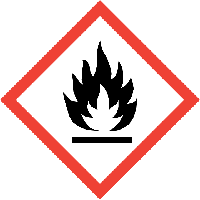Working with flammable chemicals
Many chemicals are flammable depending on the environmental conditions. Understanding when these conditions are met is needed to work safely.
Definitions
Flashpoint
The lowest temperature at which the vapours of a volatile material will ignite in air ( 20.95% oxygen) if given an ignition source.
Fire point
The temperature at which the vapour will continue to burn after the ignition source has been stopped (usually higher than the flashpoint).
Flammability limit
The concentration between which (upper and/or lower limits) upper or lower the gaseous or vaporized substance at a fixed temperature and pressure can lead to flame propagation, detonation or an explosion.
Flashpoints
Flammable Flashpoint: equal to or higher than (≥) 230C (73.40F) and lower or equal to (≤) 600C (1400F)
Highly Flammable Flashpoint: lower than (<) 230C and a boiling point higher than (>) 350C (950F)
Extremely Flammable Flashpoint: lower than (<) 230C and a boiling point lower than (≤) 350C
Non-flammable chemicals
Concentrations outside both limits are considered to be non-flammable. Flammability limits vary with temperature and pressure. However, the normal expression is in terms of % of volume at 25 °C at 1013.25mbar (mean sea-level atmospheric pressure (MSLP)).
This information can be found on the Safety Data Sheet (SDS) for the substance.
Flammable chemicals

All chemicals known to be flammable will display this symbol.
Last updated: Thursday, September 30, 2021
 Close
Close


